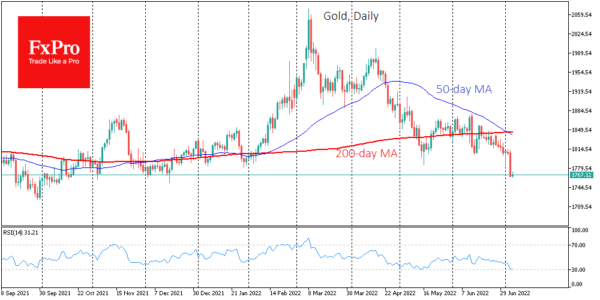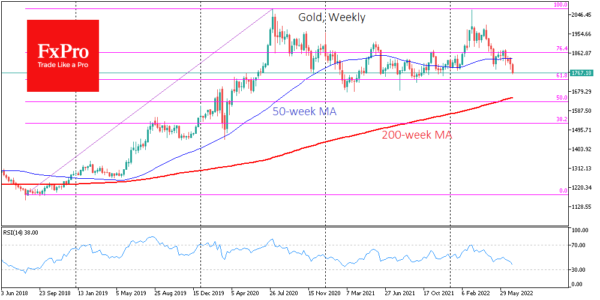Gold collapsed more than 2.3% in trading on Tuesday, the second steepest daily drop a year after falling 2.5% on June 13. The sharp decline yesterday was due to a combination of several negative factors.
The most obvious factor is the sharp rise in the Dollar on forex, where the DXY index (a basket of the world’s six most popular currencies) has renewed its highs over the last twenty years. Gold often acts as an “anti-dollar with leverage” for investors, so it was unsurprising to see such a market reaction yesterday.
The second possible explanation is a bearish signal, the “death cross”. The 50-day Moving Average fell below the 200-day MA on Monday, but we saw a full-swing market reaction only after liquidity returned after the long weekend in the USA.
The third factor was the continuing sell-off in industrial metals and the drop in Silver due to the worsening global economic outlook. Silver dipped below $19 an ounce on Wednesday morning, the lowest since July 2020.
The price of Gold is now at its low since late last year. This position simultaneously shows us buyer strength and tremendous potential for a decline.
That said, the fundamental factors behind Gold’s weakness are still in place, from a sharp tightening of monetary policy to weak demand for Gold from central banks and investors whose spending has increased significantly in recent months.
A critical intermediate stage in the Gold price decline looks to be the $1730 area, where a 61.8% correction from the 2018-2020 rally, from where Gold gets good demand from last August to September, is taking place.
A double top is forming on the long-term Gold charts, showing the inability of bulls to consolidate the price above $2000/oz the last cycle. A ‘double top’ pattern would form with consolidation below $1700, the March local lows. The final downside target in case of a double top could be the $1300 area, which could take up to six quarters to reach.














